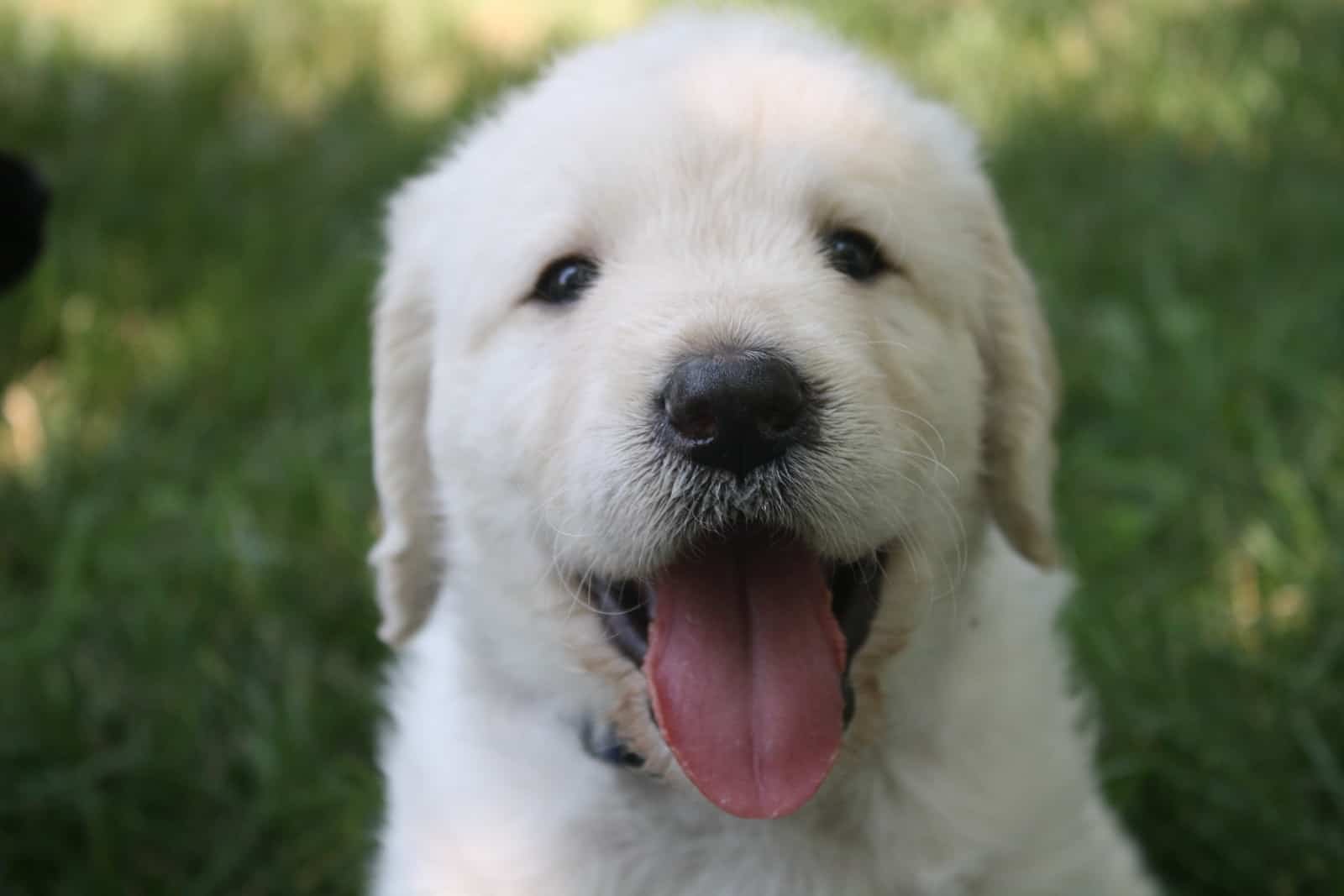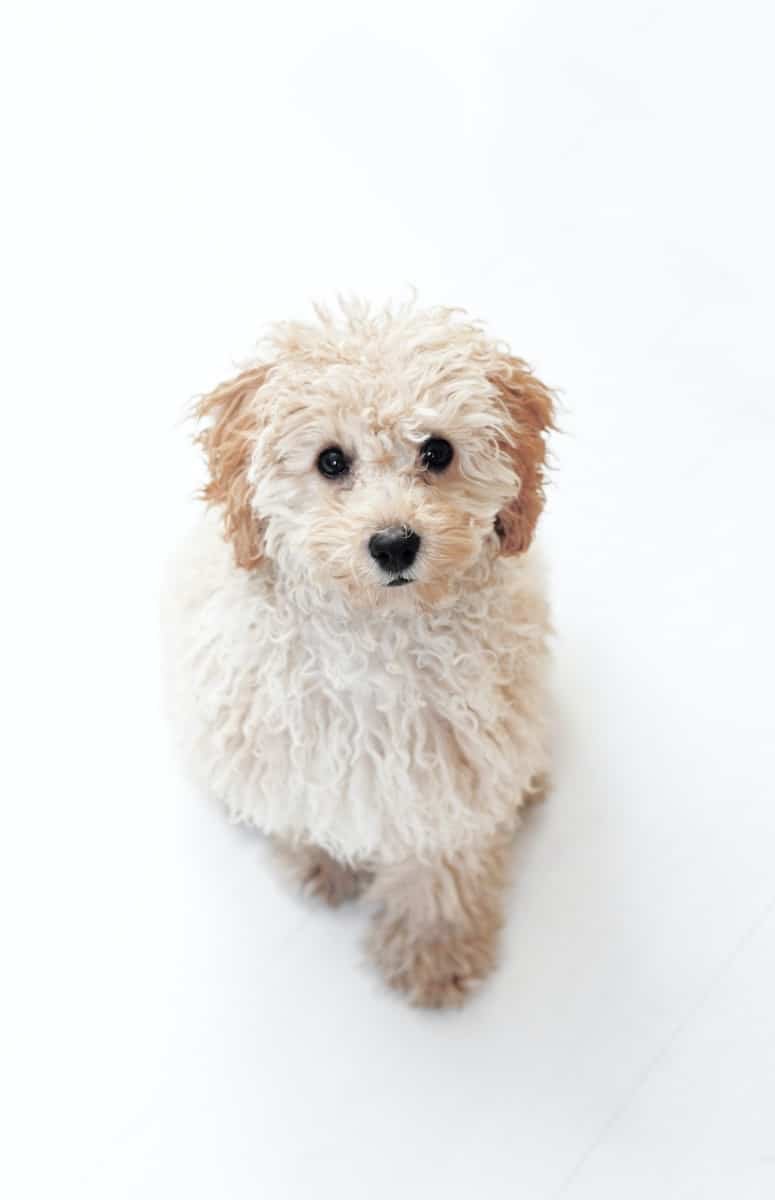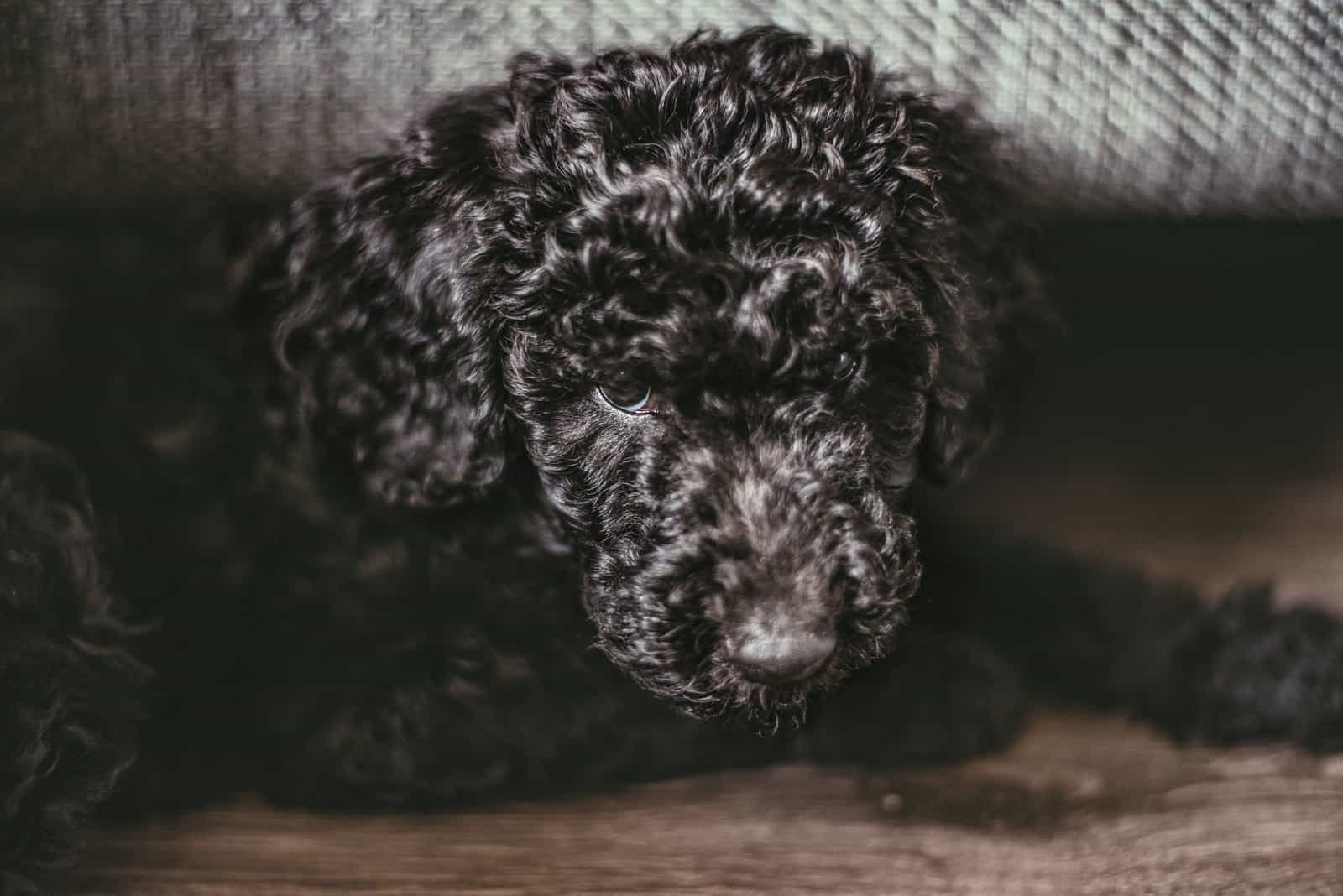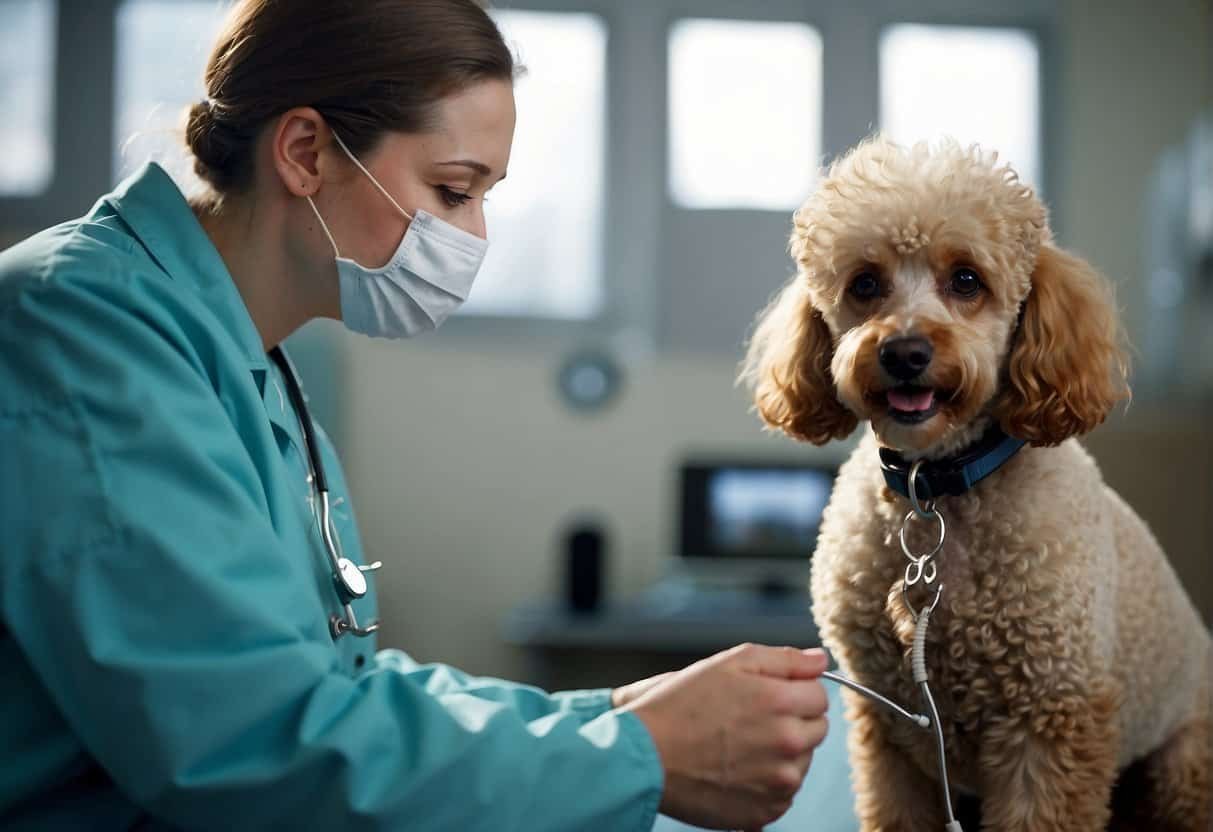
Giant Poodles are a popular breed of dog for a reason – they make fantastic pets. Their large size and curly coat make them lovable furry friends for pet owners who want a healthy, intelligent breed that is loyal and protective. They require daily exercise and mental stimulation to keep them happy and healthy, but with the right training and attention of their owners, they can grow up to be gentle giants and excellent family dogs.
Poodles, according to the American Kennel Club and the United Kennel Club, are only recognized from the following breeds: Standard, Miniature, and Toy. The largest size, the Giant Poodle, can reach a weight of up to 100 pounds at full maturity. While they are not an aggressive breed, they may require early socialization and regular training classes because of their size and potential health issues, such as hip dysplasia.
Giant Poodles usually have good health, but can suffer from genetic and skin diseases.. They have a dense, curly coat that requires regular clipping and grooming to keep it healthy. Despite their large size, Giant Poodles are agile and athletic, making them ideal for advanced obedience classes and competitions. And with their people-pleasing nature, they are excellent at learning new tricks with advanced trick training.
The Basics of Giant Poodle Size
Giant Poodles are a large-sized dog breed that is intelligent, healthy, and has a curly coat. They are gentle giants and make excellent family dogs. They are also recognized by several breed clubs, including the American Kennel Club, United Kennel Club, and the United Poodle Association.
Size and Weight
Giant Poodles are the largest among the Poodle types, with an adult weight ranging from 45 to 90 pounds and an adult height of 24-30 inches. They are heavier and taller compared to their Standard Poodle and Royal Poodle counterparts. Miniature Poodles and Toy Poodles are much smaller in size.
Coat and Colors
Giant Poodles have a dense, curly coat that requires regular clipping to keep the coat healthy. They come in a wide variety of solid colors, ranging from apricot to silver, and even multi-colored variations. Corded coat types are less common.
Exercise and Mental Stimulation
Giant Poodles require daily exercise and mental stimulation to maintain their high energy levels. Regular exercise helps prevent potential health issues like hip dysplasia and joint dysplasia. Mental stimulation helps keep these intelligent breeds from becoming bored and potentially destructive.
Health Issues
Giant Poodles are a healthy breed. They may develop health issues such as genetic diseases, skin problems, GDV, Addison’s disease, and patellar luxation. Prospective owners should keep up with regular veterinary appointments to prevent potential health issues.
Training and Temperament
Giant Poodles are an intelligent breed, and training classes can help keep them mentally stimulated. They also have a people-pleasing nature, making them an excellent candidate for advanced obedience classes. They are good-tempered and make for excellent family dogs but should not be used as guard dogs as they are not an aggressive breed.
Life Expectancy
Giant Poodles have a life expectancy of 10-18 years and require regular grooming and daily exercise to maintain their energy levels. They are great for people living with allergy as they shed little to no dead hairs.
In conclusion, Giant Poodles are a brilliantly athletic breed that makes great furry friends for pet owners. They require a significant amount of daily exercise and mental stimulation in addition to regular grooming and veterinary appointments to maintain their good health. When trained correctly, they are a joy to have and make great life companions.
Determining the Standard Size of a Giant Poodle
Giant Poodles are a large breed of Poodle accepted by many kennel clubs.. These dogs are loyal furry friends and great family dogs, but owners should know that they require daily exercise and mental stimulation to stay healthy physically and mentally. In this section, we’ll discuss how to determine the standard size of a Giant Poodle and potential health issues associated with this breed.
Standard Size of a Giant Poodle
The Giant Poodle is the largest of the Poodle types, with an adult height of over 15 inches (38 cm) tall. According to the AKC breed standards, Giant Poodles should weigh between 45-70 lbs (20-32 kg) as adults. However, the actual size of a Giant Poodle can vary depending on factors such as genetics, gender, and diet.
The Giant Poodle breed necessitates periodic clipping of its thick, curly fur for ideal wellbeing. It comes in different hues, such as silver, beige, apricot, and black.
Health Issues
Giant Poodles are generally healthy breeds, but like all dogs, they are prone to certain genetic diseases and potential health issues such as hip dysplasia, patellar luxation, and skin conditions. Prospective owners should be aware of these issues and regularly take their Giant Poodle to veterinary appointments to ensure their furry friend stays healthy.
To prevent common health issues in Giant Poodles, it is important to provide them with regular exercise and mental stimulation through stimulating activities and training classes. Owners can also feed their Giant Poodle a balanced diet to promote a healthy coat and prevent allergies.
Conclusion
In conclusion, Giant Poodles are intelligent, healthy, and gentle giants. They make excellent family dogs and can be trained for advanced obedience classes and competitions. However, owners should be prepared for regular exercise and grooming as well as potential health issues. If you’re looking for a loyal furry friend with abundant energy and a calm nature, the Giant Poodle may be the perfect addition to your family.
Height and Weight Variations in Giant Poodles
Giant Poodles are one of the largest poodle types and differ from the Standard Poodle in size, being larger and heavier. As per kennel club standards, Giant Poodles stand more than 18 inches at the shoulder and weigh between 45 to 70 pounds.
Compared to their standard counterparts, Giant Poodles have a larger furry frame, which requires regular exercise and freedom of movement to prevent potential health issues like hip dysplasia, patellar luxation, skin conditions, and genetic diseases. With proper diet and daily exercise, Giant Poodles can live a healthy life with a life expectancy of up to 12 years.
The adult weight of a Giant Poodle can vary based on diet and daily exercise routine. While exercising them, it’s important to keep in mind any potential health issues that Giant Poodles are prone to, including hip dysplasia, sebaceous adenitis, and skin diseases. Regular clipping of their dense, curly coat is necessary to maintain a healthy coat and prevent dead hairs from accumulating, which can lead to skin allergies in sensitive allergy sufferers.
Giant Poodles haircuts are similar to Standard size poodles. Thery’re a solid colored breed, ranging from apricot to silver beige and judged in a variety of colors. Their thick, curly hair requires regular maintenance to prevent matting, especially if left untouched for long periods. Daily brushing of their corded coat is necessary to prevent potential skin diseases and allergy symptoms.
Giant Poodles make great family dogs with their gentle nature and people-pleasing attitude. They are intelligent, and training classes with respect training and humane, reward-based training will reward you with a well-behaved Giant Poodle. There are advanced obedience classes and competitions for poodle enthusiasts who want to push their training to new heights.
In conclusion, although classified as an athletic breed, Giant Poodles are calm in nature and don’t require the same level of mental stimulation as their smaller miniature or toy poodle counterparts. Unlike some aggressive breeds, Giant Poodles have a good-tempered, healthy family companion reputation. Prospective owners need to keep in mind their potential health issues and veterinary appointments. Giant Poodles are not just furry friends but could also act as guard dogs.
Factors Affecting the Size of Giant Poodles
Giant Poodles are a popular breed of large-sized dogs with a curly, dense coat that comes in a wide variety of colors. This breed is known for its intelligence, good temperament, and athletic ability, and has been a favorite among pet owners, circus performers, and poodle enthusiasts all over the world. However, before bringing home a Giant Poodle, it’s important to know the factors that can affect their size and potential health issues they might face.
Genetics and Breed Standards
Giant Poodles are registered with kennel clubs like the American Kennel Club (AKC), United Kennel Club (UKC), and the United Poodle Association (UPA). According to the AKC breed standards, a Giant Poodle should have an adult height of over 15 inches at the shoulder, and an adult weight of 45-70 pounds. These dogs are bred to be healthy, athletic, and good-tempered, but like any breed, they can be prone to genetic diseases such as hip dysplasia, patellar luxation, and Addison’s disease.
Environment, Exercise, and Mental Stimulation
Giant Poodles are high-energy dogs that require daily exercise and mental stimulation to stay healthy and happy. Prospective owners should be prepared to provide ample opportunities for their furry friends to run, play, and engage in stimulating activities like advanced obedience classes or agility competitions. Without regular exercise and mental stimulation, Giant Poodles may become bored, anxious, and may develop separation anxiety.
Health Issues and Veterinary Appointments
Like all breeds, Giant Poodles are prone to certain health issues such as skin conditions, allergy symptoms, and potential life-threatening conditions such as gastric dilation-volvulus and sebaceous adenitis. Regular veterinary appointments and grooming are essential to keeping your Giant Poodle healthy and happy. Their dense, curly, and corded coat should be clipped regularly, and dead hairs should be removed to keep their coat healthy.
Growth and Adult Size
Giant Poodles usually reach their adult weight and height at around 18 months of age. However, their growth rate can vary depending on several factors such as genetics, environment, and potential health issues. It’s important to note that their adult weight and height can differ from the breed standards, and that some Giant Poodles may have a broader or taller frame than their standard counterparts.
In summary, if you’re planning to bring home a Giant Poodle, it’s important to provide them with a healthy environment, regular exercise, plenty of mental stimulation, and veterinary appointments to keep them healthy and happy. Despite their potential health issues, Giant Poodles are a healthy breed overall and with proper care, they can live a long and happy life as gentle giants and good-natured family dogs.
How to Care for a Giant Poodle of Any Size
Giant Poodles are an intelligent breed known for their dense, curly coat. They are gentle giants and make excellent family dogs, but potential pet owners should take note of potential health issues, such as hip dysplasia and skin diseases. In this guide, we’ll cover everything you need to know about caring for a Giant Poodle of any size.
Exercise and Mental Stimulation
Daily exercise is essential for Giant Poodles. They have abundant energy and require plenty of mental stimulation to prevent destructive behavior. Consider training classes or advanced trick training to keep them engaged and active.
Coat and Grooming
Giant Poodles have a dense, curly coat that requires regular grooming to keep it healthy and free of dead hairs. Clipping should be done on a regular basis to promote movement and freedom. Corded coats require extra maintenance, so prospective owners should consult a professional groomer.
Health Issues and Potential Health Problems
Like all poodles, Giant Poodles are a healthy breed. However, they are susceptible to genetic diseases, including hip dysplasia and Addison’s disease. Skin conditions, such as sebaceous adenitis and allergic skin disease, are also common. Regular veterinary appointments are crucial to keep Giant Poodles healthy.
Training and Temperament
Giant Poodles are calm, good-tempered dogs that thrive on pleasing people. Respect training and humane, reward-based training methods are recommended for all poodles, including Giant Poodles. Prospective owners should consider advanced obedience classes or even competition to keep their Giant Poodle’s mind stimulated.
Size and Color Varieties
Giant Poodles can grow up to 27 inches tall and weigh up to 90 pounds as adult dogs. They come in a wide variety of colors, from apricot to silver beige. Toy and miniature poodles are smaller than Giant Poodles and also make great family dogs.
In conclusion, Giant Poodles are an athletic breed with a calm nature and good temperament. With proper care, exercise, and mental stimulation, they make excellent furry friends. As always, it’s important to research breed standards and consult with breeders or poodle enthusiasts before adding a Giant Poodle to your family.
Feeding Requirements for a Giant Poodle
Giant Poodles are a striking and intelligent breed of large-sized dogs, much loved by dog enthusiasts across the world. These gentle giants weigh between 60 to 100 pounds when fully grown, and are known for their thick and curly coat, which requires regular clipping and maintenance to keep it dense and healthy. In this section, we will dive into the feeding requirements for these furry friends to ensure they remain healthy and active.
Dietary Requirements
It is essential to feed your Giant Poodle a balanced diet that meets their energy requirements. Giant Poodles are energetic dogs that require a substantial amount of daily exercise and mental stimulation to prevent boredom and keep them healthy. They are prone to potential health issues, such as hip dysplasia and skin diseases, which require a healthy and consistent diet.
As a rule of thumb, it is recommended to feed your Giant Poodle 2-3 cups of high-quality dry dog food per day, depending on their age, size, and energy level. Be sure to provide them with a daily exercise routine that includes long walks, interactive playtime, and stimulating activities, such as obedience classes.
Nutritional Considerations
Giant Poodles have a dense and curly coat that requires proper nutrition to maintain its texture and health. They require a diet rich in vitamins, minerals, and essential fatty acids to keep their coat healthy and shiny. Additionally, they are prone to potential health issues, such as joint dysplasia and skin conditions, which require careful consideration of their nutritional needs.
When selecting dog food for your Giant Poodle, ensure that it meets the breed’s dietary and nutritional requirements. It should be well-balanced and free of artificial additives, colors, and preservatives. Also, keep in mind any food allergies or intolerances your furry friend may have and choose a food accordingly.
Feeding Routine
It is essential to maintain a consistent feeding schedule for Giant Poodles to prevent life-threatening conditions such as gastric dilatation-volvulus, or bloating. Do not feed them immediately before or after exercise, and ensure to provide them with enough water throughout the day.
Giant Poodles can overeat if given the chance, which can lead to obesity. Regular veterinary appointments can help manage your furry friend’s weight and reduce the risk of potential health issues.
In conclusion, Giant Poodles make for brilliant family dogs, and their friendly and people-pleasing nature makes them a favorite breed for many poodle enthusiasts. As with all poodle types, it is crucial to keep them healthy, active, and mentally stimulated to ensure that they remain happy furry friends. By following these feeding requirements and consulting with your veterinarian, you can provide your Giant Poodle with a healthy and nutritious diet that will allow them to live a long and happy life.
Training and Exercise for Giant Poodles of Different Sizes
Giant Poodles are a brilliant breed and one of three types (the Standard Poodle and Toy Poodles are the other two) of the well-known Poodle breed. Giant Poodles are the largest type of Poodle and are recognized as a separate breed from their smaller Standard counterparts.
As with all Poodles, Giant Poodles are intelligent, healthy, and have a furry coat that is curly, dense, and comes in a wide variety of colors. Their coat is healthy but requires regular clipping to avoid complications such as sebaceous adenitis.
Giant Poodles are friendly and calm by nature which makes them excellent family dogs. They have a good-tempered and people-pleasing nature and can be a perfect pet option for the first-time pet owners. However, to maintain their calm nature, it is important to provide them with stimulating activities and daily exercise.
Providing daily exercise to Giant Poodles is essential to ward off potential health issues such as hip dysplasia and joint dysplasia. Giant Poodles require at least 60 to 90 minutes of exercise on a daily basis. Daily exercise should be carried out on a leash to avoid their freedom of movement.
Mental stimulation is also very important for poodles, especially for Giant Poodles. Providing mental stimulation can help ward off behavioral issues, such as separation anxiety. Regular training classes can serve as mental stimulation for them and even advanced obedience classes.
Consistent and advanced training is necessary since Giant Poodles are intelligent but sometimes stubborn. Respect training and humane, reward-based training are two types of advanced training that work best with Giant Poodles. Advanced trick training is also an excellent choice for advanced stimulation.
Giant Poodles are usually healthy, but may have inherited health issues like skin diseases or gastric dilatation. Regular veterinary appointments are necessary to prevent these life-threatening conditions.
For prospective owners considering a Giant Poodle, it’s important to note that they vary in size. An adult male can weigh up to 100 pounds while an adult female can weigh up to 85 pounds. The AKC, UKC, NKC, and UPA each have their own breed standards for Giant Poodles.
Finally, it’s important to note the variety of giant poodle colors available, including silver beige, apricot to silver, and many more. The coat can be corded or curly. Regular brushing is necessary to remove dead hairs and to keep their coat healthy in both types of coats.
Grooming Needs for Different Sized Giant Poodles
Giant poodles are an intelligent breed of dog that is loved by many pet owners. They come in different sizes like standard, miniature, and toy poodles. However, grooming needs vary depending on the size of the giant poodle. In this section, we’ll look at the grooming needs for different sized giant poodles.
The giant poodle is also known as the royal poodle and is the largest of all the poodle types. These gentle giants are larger than their standard counterparts and can weigh up to 100 pounds. They have a curly and corded coat that requires regular clipping to prevent matting. Giant poodles need regular grooming for their coat and skin health. Despite being a healthy breed overall, giant poodles are prone to certain health issues, such as sebaceous adenitis and skin allergies.
In summary, giant poodles come in different sizes, and each size has specific grooming needs. Regardless of the size, poodle enthusiasts should be aware of the potential health issues and should regularly take their poodle for veterinary check-ups. With regular grooming, exercise, and training, poodles can be a brilliant breed and make great family dogs, circus performers, and even guard dogs.
Health Concerns for Giant Poodles and Proper Size Management
Giant Poodles are considered a healthy breed overall. However, as with any large-sized dog, they are prone to certain potential health issues such as Hip Dysplasia and Joint Dysplasia. Nevertheless, these issues can be avoided by conducting regular veterinary appointments and managing their exercise and diet appropriately.
Another potential health issue many Poodle enthusiasts should be aware of is Addison’s Disease, which is a life-threatening condition that primarily affects the adrenal glands. An Addisonian crisis can cause vomiting, diarrhea, and even lead to death. Although genetic diseases are rare in Giant Poodles, prospective owners should always buy a puppy from a responsible breeder who is knowledgeable about breed standards and genetic health.
Coat health is an essential concern for pet owners. Giant Poodles have a dense and curly coat that needs daily grooming and regular clipping. The Corded Coat, commonly found in Royal Poodles, requires its unique care. Dead hairs can mat and tangle within the dense coat, leading to skin irritations and skin diseases. Many allergy sufferers appreciate the tightly curled and non-shedding coat of Standard Poodles, which make them perfect for allergy sufferers.
Giant Poodles are intelligent, and they enjoy mental stimulation through regular exercise and stimulating activities to avoid this breed’s mental health issues, such as separation anxiety and sebaceous adenitis. Prospective owners should ensure regular exercise and engage these furry friends in mentally stimulating activities. These Poodles are athletic, and they excel in advanced obedience classes and advanced trick training classes.
Poodle types come in a wide variety of colors. The Giant Royal Standard Poodle comes in beautiful colors ranging from Silver Beige to Apricot to Silver. Poodle enthusiasts always enjoy the options extended by this breed’s biggest variety in color.
In conclusion, Giant Poodles are a brilliant breed, and they make great family dogs and guard dogs. They are calm, good-tempered dogs with excellent activity levels and people-pleasing nature. The breed has a long life expectancy, usually over 12 years, but proper care and health management are critical. If you are ready to add a Giant Poodle to your family, ensure that you are getting it from a reputable breeder and know how to manage the coat and exercise regime properly. Keep your furry friend in robust health by ensuring veterinary appointments and keeping an eye out for any potential health issues.Maximizing the Benefits of a Giant Poodle Regardless of Its Size
Are you considering having a Giant Poodle as your furry friend? Giant Poodles are also known as Royal Poodles and are the largest variety of the breed. They weigh between 40-90 pounds and can grow up to 24 inches tall at the shoulder. Unlike common misconceptions, Giant Poodles are not an aggressive breed.
Despite their size, Giant Poodles are healthy breeds. However, like all Poodle types, potential health issues can still arise, such as hip dysplasia, skin diseases, and genetic diseases. Furthermore, due to their dense coat, they are vulnerable to skin conditions and allergy symptoms. It is crucial for pet owners and prospective pet owners to be aware of these health issues and provide their furry friends with regular veterinary appointments to ensure they are staying healthy.
Whether you are a seasoned Poodle enthusiast or a new pet owner, there are different training courses and videos that you can invest in to help your furry friend lead a happy life. Regular exercise and mental stimulation are essential for Giant Poodles, as they are an athletic breed with abundant energy and need daily exercise to prevent destructive behavior.
As a pet owner, it is crucial to provide your furry friend with stimulating activities such as advanced training classes along with freedom of movement regularly. They are people-pleasing breeds that enjoy obedience classes, advanced trick training, and advanced obedience competition. This way, you can ensure your giant poodle leads an engaging life that can keep them mentally and physically healthy.
Giant Poodles make excellent family dogs, thanks to their good-tempered, calm nature, and people-pleasing nature. They are sometimes referred to as gentle giants due to their size and temperament. They also make great guard dogs, even though they are not an aggressive breed. Their alertness makes them a suitable choice for keeping watch over a property.
Summary
Whether you are looking at a Giant Royal Standard Poodle or any other variety of Poodles, they require regular clipping and brushing to keep their coats healthy and free from dead hairs. With proper care and attention, Giant Poodles can live up to 12-15 years and are good-tempered, healthy family companions. When investing in a Giant Poodle or any other Poodle variety, it is always essential to be aware of their potential health issues, activity levels, and energy requirements to ensure that your furry friend is leading a happy and healthy life.
Giant Poodles are an impressive breed of pooch. With their oversized stature and beautiful coats, they can make wonderful family members. But it’s important to remember that they require special care and attention in order to stay healthy and happy. This includes regular grooming, exercise, and health checkups with your vet. For those willing to take on the responsibility, owning a Giant Poodle can be an incredibly rewarding experience.






